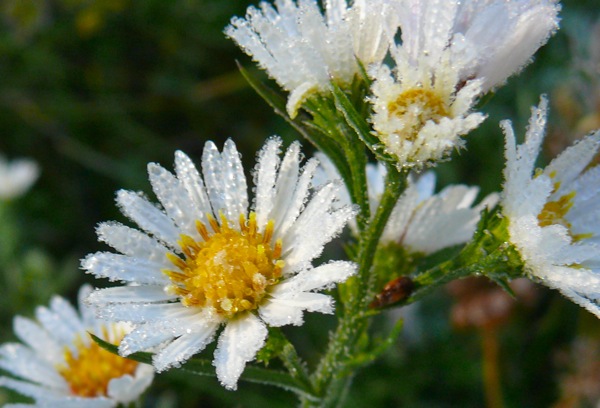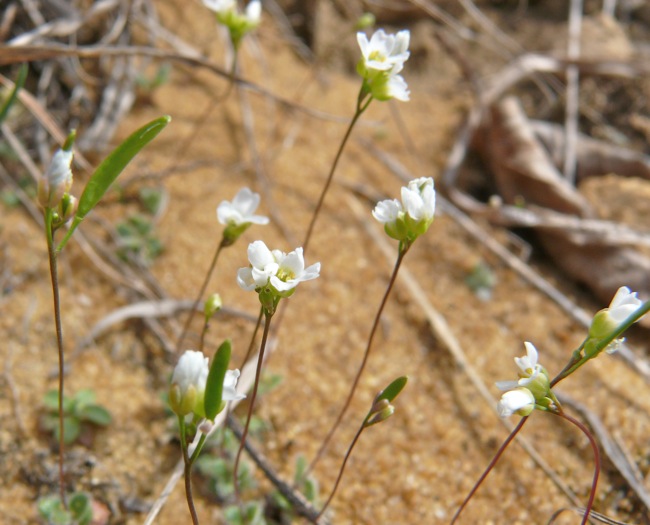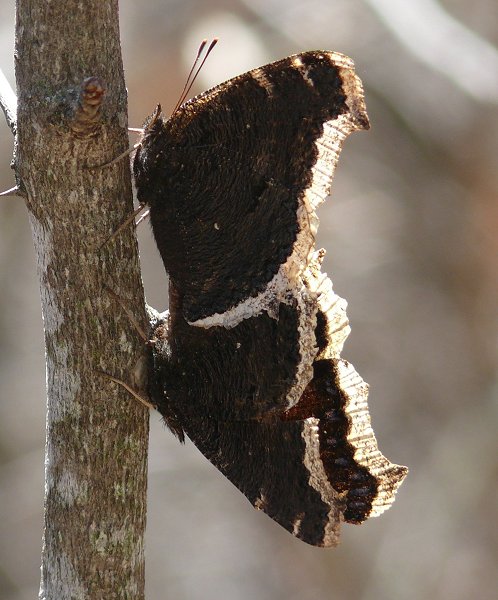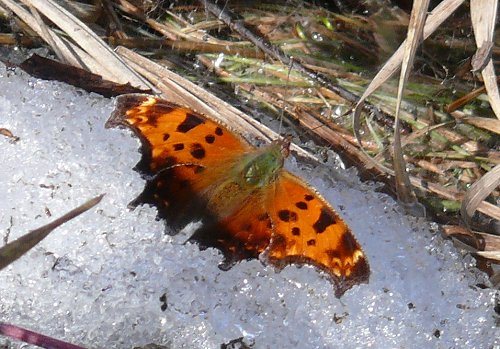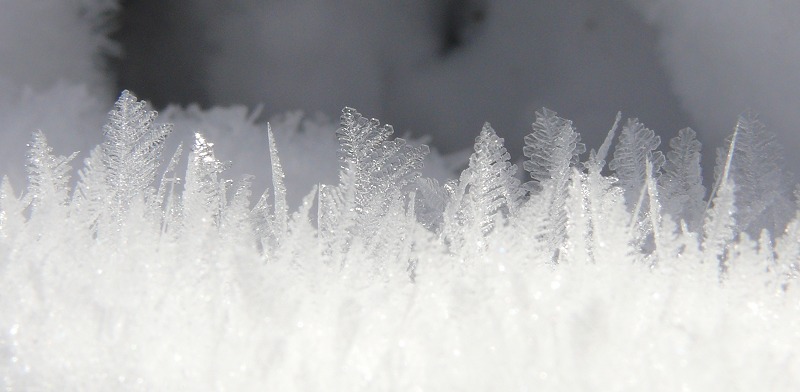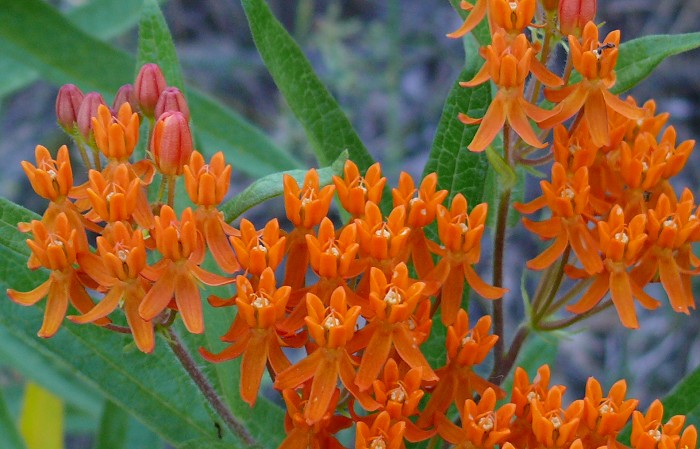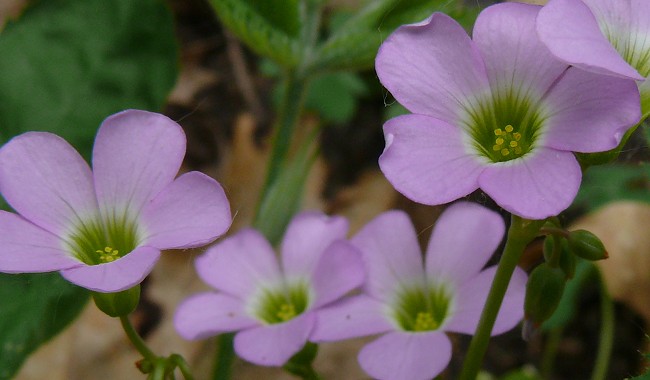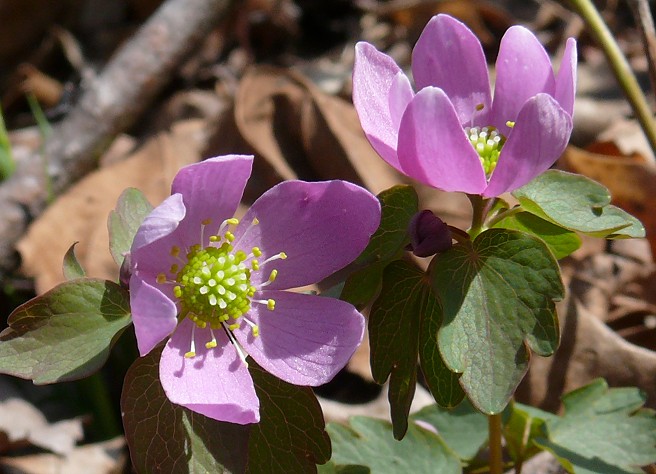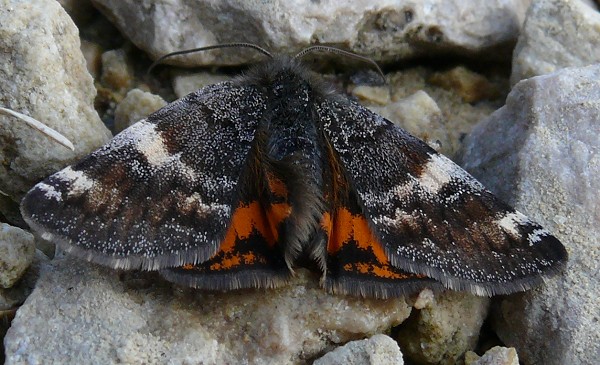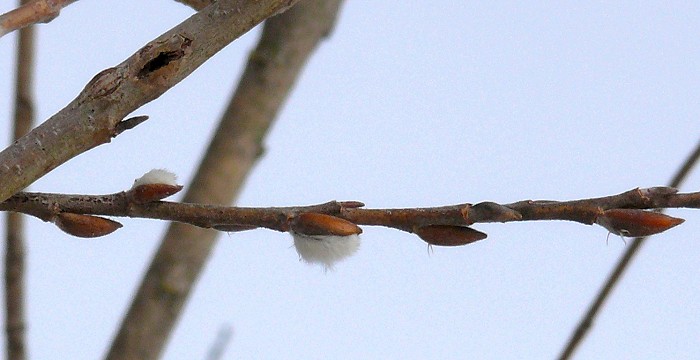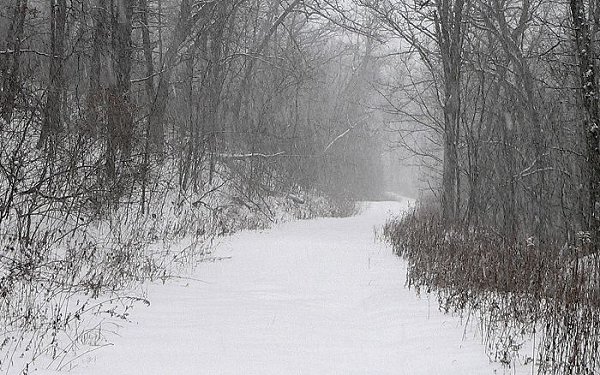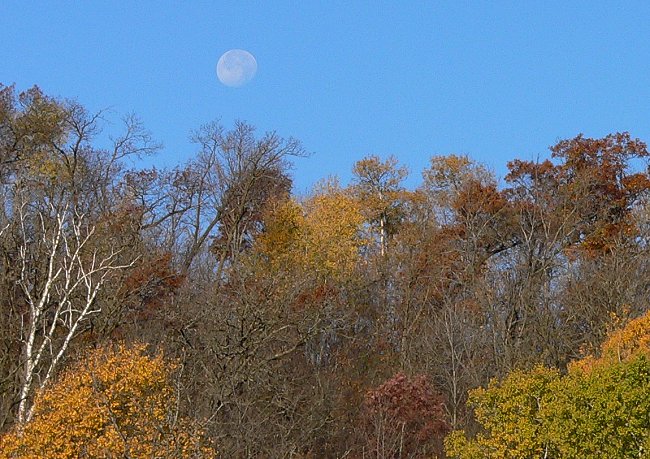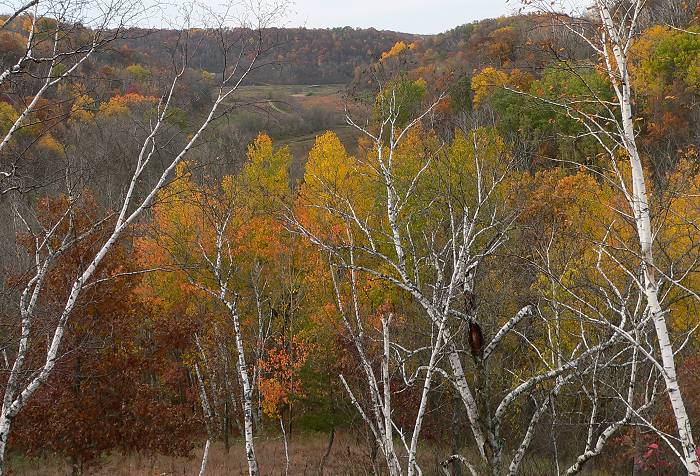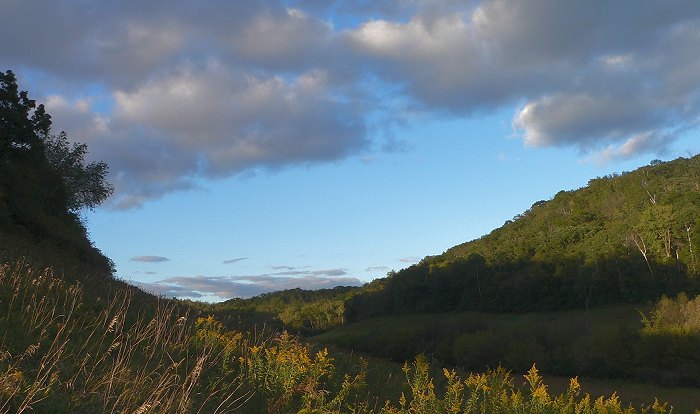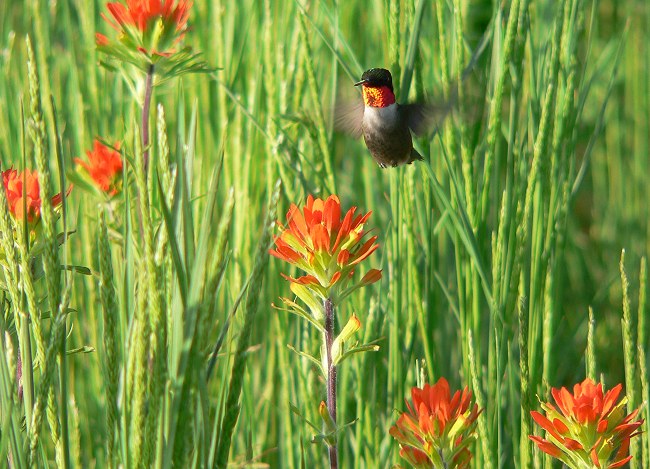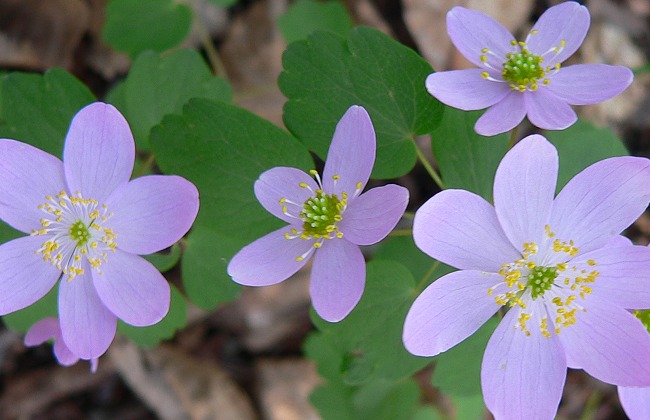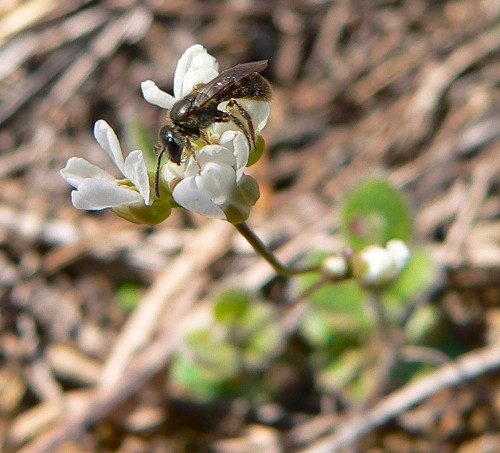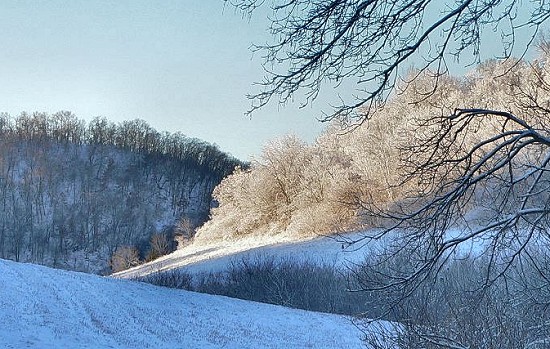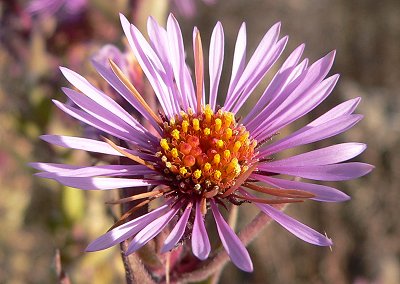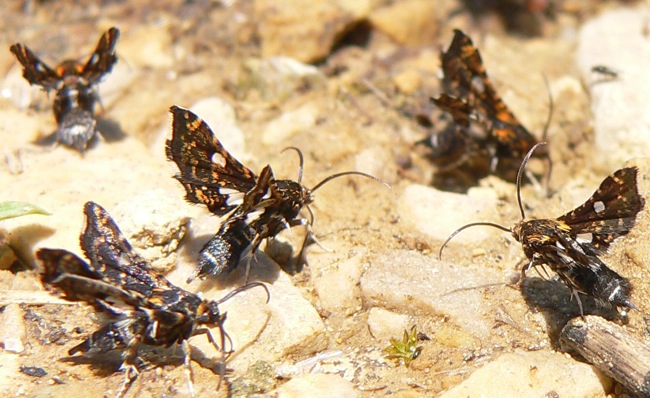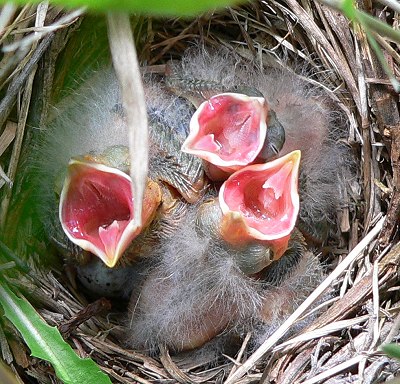This is a collection of the “Favorite Photos” I’ve used on the front page of the blog over the years, with dates that the photos were taken.
This is a Frost Aster – with frost. It was taken on October 4th 2010, just when we were starting to have hard frosts at night. In the mornings, when we took our walk, there would be frost on all the flowers. Then, when the sun came out, the frost would disappear, and it would look and feel like summer again.
October 9, 2010
This is the sun going down over one of the shallow backwaters we drive through to get back to the boat landing.
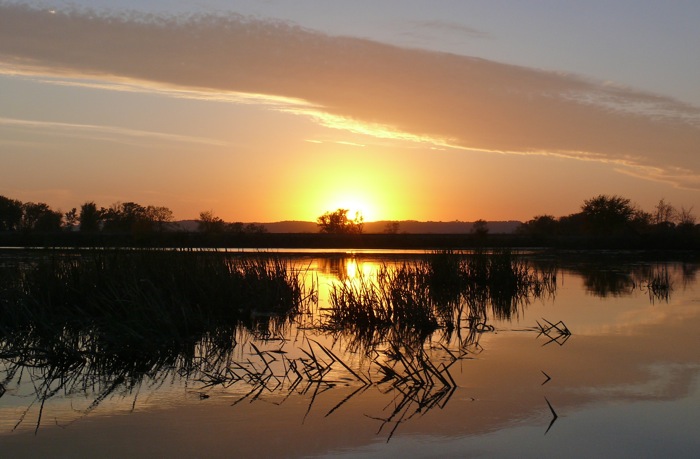
May 8, 2010
Indian Paintbrush (Castilleja coccinea) growing in the planted prairie area around our house. The bright red things are actually special brightly colored leaves, called bracts, that surround the greenish flowers. The flowers are the thin green tubes that stick out between the red leaves. Indian Paintbrush is partially parasitic on other plants. This species was historically found in this area, but I’ve never seen it growing here in the wild.
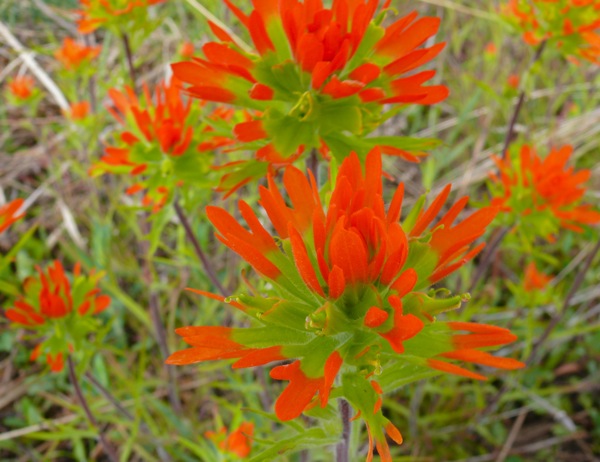
April 1, 2010.
These flowers are the first ones to bloom on our remnant bluff prairies. They’re tiny – each plant is only about an inch tall. They’re annuals, and they grow in the hottest, sandiest, steepest places. The common name is Common Whitlow Grass, even though it’s not a grass – it’s in the Mustard family.
February, 2010.
This is on the south-west facing slope of Indian Grass Point – one of our bluff prairie remnants. It’s right behind our house, so I can get to it easily, and I’ve been working hard on clearing out the brush and exposing the prairie plants that are growing under it. The bark of these birches has been girdled, so they should die this year, making the point even more open. The slope is very steep – I do all the work while on my knees.
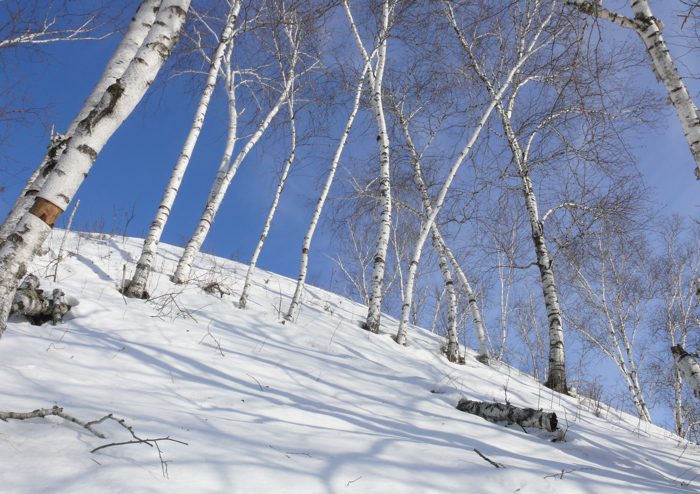
November 4, 2009
This Ruffed Grouse was sitting in the middle of the trail as I was driving the gator up the hill yesterday. It walked slowly across the trail and into the woods – watching me suspiciously and clucking all the way.
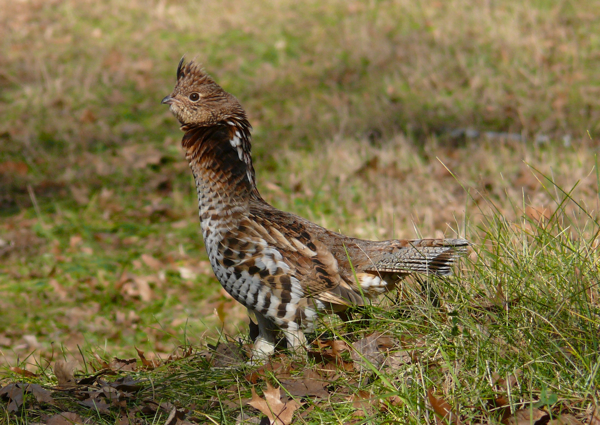
October 2009
Now that our boat is working, we’ve been exploring some of the backwaters of the Mississippi River near Alma.
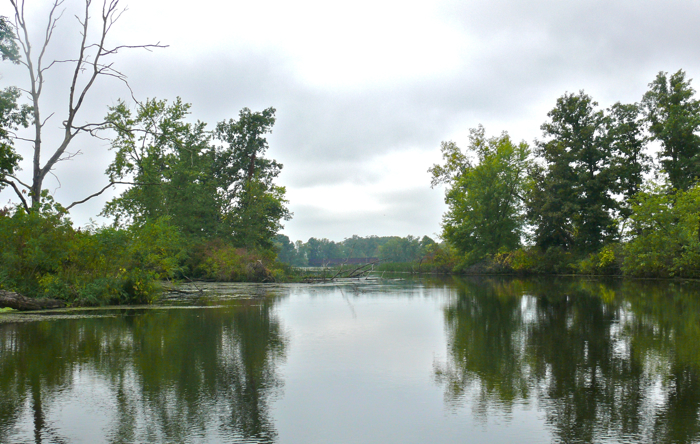
Hatched on June 1, 2009.
She attracted a male, so I collected some of the eggs she laid, and released her to lay the rest in the wild.
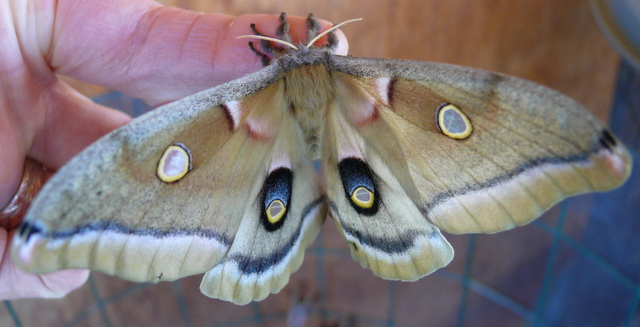
April 15, 2009
Mating Mourning Cloaks – Nymphalis antiopa

- March 16, 2009 – my first butterfly of the season. Eastern Comma – Polygonia comma

- January 2009
Ice Crystals formed after an ice storm, around the edge of a hole in the snow. 
October 2008
Red Squirrel
August 2008
Mist over the Wetland July 2008
July 2008
We only have a few plants of Butterfly weed growing naturally at the farm. This is one on the east side of Indian Grass Point. We’ve been planting it in our reconstructed prairies, so someday we’ll have many more. Asclepias tuberosa
May 2008
Violet Wood Sorrel (Oxalis violacea) is a beautiful late spring wildflower in western and south-western Wisconsin. It grows in prairies and dry woodlands.
May 2008
Cabbage Whites (Pieris rapae) are non-native butterflies that were introduced into the United States from Europe in the 1860s. Their caterpillars eat plants in the mustard family, including common garden vegetables like broccoli and cabbage.
April 2008
Rue Anemones are some of the most beautiful early spring flowers we have on our land. They grow on wooded hillsides, and bloom from mid-April until late in May. Yesterday I found a whole hillside of blooming plants. Thalictrum thalictroides
April 2008
These moths are the earliest lepidoptera – moths and butterflies – that we see at the farm. They spend the winter as pupas, and hatch as soon as it starts to warm up in the spring. I found one flying last week, when the temperature was only 37 degrees. Their larvae eat many of the trees we have on our property: birch, alder, poplar and willow.

The undersides of their wings are orange, with some brown spots and lines – I think it’s what makes them look so orange when they fly. It’s difficult to see the undersides, because most of the time they are either flying or sipping water from muddy puddles in the driveway. This is the only photo of them that I’ve ever gotten.

March 2008
Early Blooming Willow; As soon as the temperature warms a little, the fuzzy blossoms on the willow trees start to open. They looked a little frozen on this below zero day, but they mean that spring is really coming soon.
December 2007
This is our farm road through Western Valley, during a snowstorm.
November 2007
Moon over Center Valley
October 20, 2007
This is a view from the top of the Knife Edge Point, looking south.
September 2007
Fall in Center Valley
May 2007
Hummingbird with Indian Paintbrush;I was admiring some Indian Paintbrush (Castilleja coccinea) that’s growing in Buffalo Ridge Prairie, when a hummingbird buzzed in and started drinking nectar from the flowers. Indian Paintbrush is a perfect hummingbird flower – hummingbirds are attracted to red, and they can reach to the bottom of the long narrow throats of the flowers with their slender bills.

Here’s a closeup of an Indian Paintbrush flower. The bright red actually comes from modified leaves, not from the flower. The flowers are the tiny green tubes – with red rims – that stick out from the stalk between the red leaves.

April 2007
Rue Anemone (Thalictrum thalictroides) The Rue Anemones are blooming now on our wooded hillsides. They also grow in savannas and woodland edges.
April 20, 2007 – First Flower of Spring
This is the first blooming plant I’ve found this spring (other than trees). It’s called Common Whitlow-grass. It’s actually not a grass – it’s in the Mustard Family and its latin name is Draba reptans. It’s very small – the plant is one or two inches tall, and each flower is less than 1/2 inch across.
Common Whitlow-grass is native to Wisconsin, and grows in dry, sandy, open prairies and hillsides. This small insect was visiting each of the flowers.

March 28, 2007 – Mourning Cloak Butterfly
Mourning Cloaks are one of the first butterflies to fly in the spring because they over winter as adults. They spend the winter in crevices behind bark or in log or brush piles. If the temperature warms to 55 degrees and the sun is shining, these butterflies will come out to bask in the sun in a sheltered place, even in the middle of winter. This one flew past me in the woods and landed on a branch right in front of my face.
Mourning Cloaks are in a group of butterflies called “Anglewings” because of the jagged points along the edges of their wings. Most Anglewings have bright colors on the top surface of their wings, and dull brown colors on the undersides. When they close their wings, they look like dead leaves.
Since there are no flowers this early in the year, Mourning Cloaks and other Anglewings will sip tree sap as well as nectar.
Here’s a link to a story I did about Mourning Cloaks – with more photos.

March 16, 2007 Oak Leaves with Hoarfrost
Hoarfrost forms on the edges of leaves and on twigs when the air is humid and the temperature is below freezing. If we have a warm day with lots of snow melting, and then a cold night, we often find hoarfrost on leaves and twigs the next morning.
January 1, 2007 New Years Snowstorm
This is what we woke up to on New Year’s morning.
January 2007
This buck was standing, watching me, as the sun was setting on Western Prairie.

November 5, 2006
New England Aster (Aster novae-angliae) has a very long blooming period. It begins in August and continues late into the fall. I found this one blooming today even though everything around it had turned brown.

July 2006 – Eastern Tailed Blue Butterfly
Eastern Tailed Blues are very small butterflies – about an inch when measured across their open wings. This one is a female. I found her on a steep dry prairie that belongs to our friend Rob. She was very cooperative – I was able to get the camera very close before she flew away. To see more photos, and more information click here.

June 28, 2006
Spotted Thyris Moths – Thyris maculata
These are tiny moths – less than half an inch long – that I found on the driveway. They were with large fluttering groups of butterflies, all sucking up the salt and minerals left from evaporating rainwater, dead animals and animal scat. Usually the moths or butterflies doing this are males, and the salts are used in mating. To see more about these moths, and more photos, click here.
To see more about these moths, and more photos, click here.June 2006 Baby Field Sparrows
These guys were waiting for someone to bring them some food. They would open their beaks for a second, then close them when nothing went in. I made a little clicking noise and they opened them again and I was able to take the photo. I wonder if the parents make a little noise to let them know it’s time to open up.The nest was on the ground in the Cat’s Paw Prairie, well hidden under the leaves of a prairie plant. I only discovered it because I nearly stepped on it and one of the parents flew up from right under my feet.
I watched for a while from a distance and saw the parent come back toward the nest with a caterpillar in its beak.


April 16, 2006 Pasqueflower – Anemone patens
This is actually from my friend Jackie’s prairie – I still haven’t been able to find any Pasqueflowers on our land. They grow on dry sandy prairies and are one of the first flowers to bloom – usually in late March or April.

